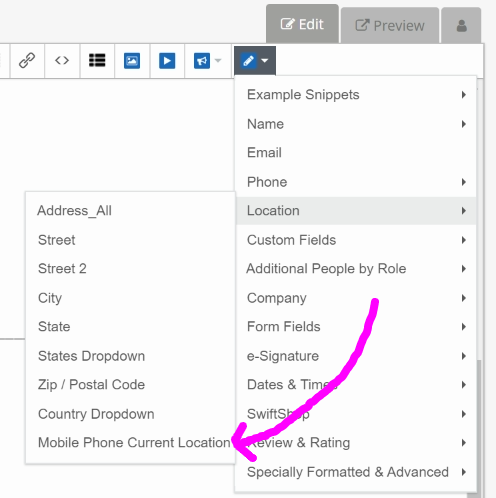We are developing an e-Sign Bill of Lading for a very large fortune 500 company that contains some special features worth mentioning.
Naturally, it has our fabulous electronic signature in it, but much more. All of SwiftCloud is by default phone accessible, and e-Docs even support offline access (read: no cell signal- they’ll store the signature, then sync to the server when reconnected).
April 3, 2020 Update: Some of the features below are still in beta; if you need this, contact us for free beta access – we should have this all polished up in the coming few weeks.
New systems and shortcodes created related to this electronic Bill of Lading project include…
- e-Signature Location. For each signature along the path, we can include the signer’s longitude and latitude as hidden variables. This is a shortcode can be added into any document for additional info, and/or additional authentication such as field installation. To use it, just drop in [swift_phone_geolocation required]. Making it required will force the signer to accept the popup on their phone. For each signature along the journey, we’ll store the long / lat location into the file, append a map to the PDF, and show the map in the contact-history.

- Bar Codes: Some companies use bar codes to scan loads and pallets in and out. You can now easily add bar codes (a variety of types, to be precise, including UPC etc) into any doc. This may be helpful if you’re using some other software system you wish to integrate. If you need automatic tracking in SwiftCloud, let us know – our upcoming gym membership type system already supports bar code scanning, so we have parts of this already done and just need to connect a few dots with your help.
- TIP: We can tie bar-codes to Tags, so a contact could be automatically tagged with “#Arrived” or “#InTransit”.
- Contact Location Maps: The contact shows you events done by a given contact. As we refine this system, we’ll directly embed a map, and so each time an item is signed, you’ll be able to see the location along with time-date stamping and a full audit log. Naturally, the carrier can invoice you through SwiftCloud as well if you / they choose, and that would be in the same history.
TIP: SwiftCloud allows filling data via API, and can post back to APIs (inbound + outbound). APIs are how software systems talk to each other.
Using your Electronic Bill of Lading:
We have a few ways to generate your BoL – which are…
- Fill it out on the front-end using “Sessions”. Most recommended for companies with larger volumes – a bit more setup work, but then it’s easy and scalable and you can do hundreds / thousands / millions faster.
- Clone a Copy. This is easier if you need a variety of form details that may not fit the template as consistently, i.e. hazmat one week, ag the next. Just click Save >> Save a Copy. You can then modify the doc on the backend.
- PDFs are not ideal in all cases, but if you have an exact format you must use (i.e. government work), then you probably need PDFs. The major downside to PDFs is they won’t format very well to phone signature (we have to match the doc exactly), and there cannot be smart logic (if X, do Y) embedded. We’ll usually try to steer you away from this if we can, and we can get the “responsive” shortcode system pretty well formatted so it will still look close to your classic Bill of Lading form, but will still format to a mobile phone screen / tablet, etc.
More tips about our Electronic Bill of Lading systems:
- The Notify Party is defined in the blue box, and you can have any number of them. They’ll get a copy of the doc each time it’s signed. TIP: you can include the insurance agent on this if you want.
- By default the signer will get a copy, so the carrier will see a copy along with the notify party.
As we roll our our Tasks & Project manager (in beta), we can append some of these location functions to a project. The hierarchical nature of our project manager automatically lends itself to split palettes, or a bunch of containers on a ship or train, each with its own Bill of Lading.
To join the free beta group, contact us.
Future ideas:
- Status tracking – there’s a few ways to do this now (just add a dropdown into the doc); this should get tied to tags (i.e. on-board, straight vs received for shipment, order BoL, etc)
- GPS tracking real-time updates via API.
Further reading:
- Bill of Lading Template (available free after signup; clone a copy then customize as needed)
- Bill of Lading general info – Wikipedia

